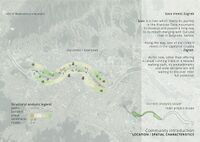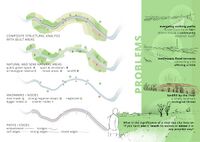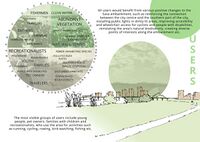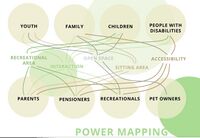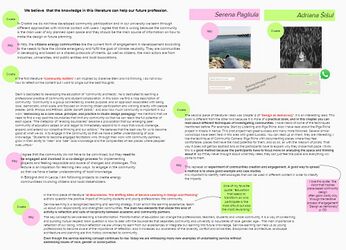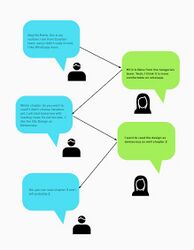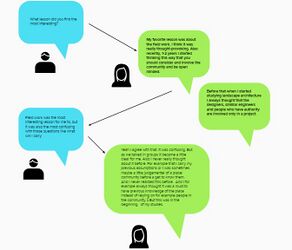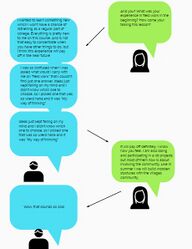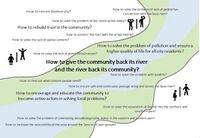LED2LEAP 2021 - Zagreb Team 2: Difference between revisions
Ivona.poljak (talk | contribs) |
Ivona.poljak (talk | contribs) |
||
| Line 169: | Line 169: | ||
== The Actors in Your Story of Visioning == | == The Actors in Your Story of Visioning == | ||
The following scene represents the main stakeholder in our community. River Sava represents the main actor that runs through Zagreb as its main vessel. Mayor and city administration represent stakeholders that are not physically present on the area but are the ones that can have the most effect in terms of organizing various events and public contect on the area which effects on frequency and perspective of use. Smaller associations that can organize smaller activities in the area for specific or mixed communities with different interests. Reporter should be the one who is spreading the news of such events and important decisions that concern river Sava. Informing the wider population and talking about current problems or even just mentioning Sava as part of the city will ‘wake up’ the community and make them aware of its potential. Ivan, Luka, Zvonimir and Sara are actors in the scene and are representing parts of the local community. Their perception and needs from space have huge relevance to what the previous actors should be making an imprint on. | |||
<gallery caption=" " widths="200px" heights="150px" perrow="5"> | <gallery caption=" " widths="200px" heights="150px" perrow="5"> | ||
Revision as of 15:46, 9 June 2021
>>>back to working groups overview
For help with editing this Wiki page use this link.
For assignments and key readings use this link.
Landscape Democracy Rationale
Our objective is to identify and respond to clearly visible landscape problems along the Sava river in an inclusive and democratic way. Although reaction is necessary to transform the area into an accessible and sustainable space, it is imperative to make community members main contributors in any landscape project or practice.
Location and Scope
Phase A: Mapping Your Community
Welcome to Your Community and Their Landscape
Due to the big site area, there is a diversity of communities that inhabit the space around The Sava River. They include a lot of contrasting users who vary from low income communities more present in the eastern parts to high income communities more present in the western parts. The most visible users are the ones who use the space for recreation (families, students, youth, elderly people) and sport (sports club members). Some problems include inaccessibility of the river itself (especially for people with physical disabilities), monotony of the area, division of the north and the south part of the city, health issues due to garbage disposal situated very close to the river and overall lack of content which would activate the space around the river thus making it a place of quality leisure time. There is also a question of privatization which leads to transformation of neglected, unused public areas into privately-owned areas which are more profit than community driven. One of the examples is a golf club just south of the river. While the quality of the space is far from low, it's unavailable for the majority of the citizens of Zagreb.
We have singled out few most important challenges which we found as most important:
- no access to the river as well as low access due to pavement (people with disabilities)
- paths on embankments that are not continuous and on few points can be dangerous, not paved and expect drastic change of direction (walking under the bridge which can provide problems to cyclist or parents with children)
- lack of content that invites people to use the area
- biggest problem is ecological - situation of garbage disposal being positioned right next to river, across protected landscape area and orinthological reservoar as well as aquifer area
Groups of Actors and Stakeholders in Your Community
Urban points where communities gather can be divided into two basic groups: anthropogenic and natural points. Anthropogenic being tram turnaround where a lot of different communities gather and natural being parks where communities meet for various kinds of activities. Various and wide range of groups are present due to large area. There are recreational athletes for horse riding, runner or cyclist as well as people just having barbecue and socializing. There are people who respect the space as well and people who don't. That can also be interpreted on how people perceive the space, having people asked, many of them don’t perceive river Sava as something that exists thus having Sava at big risk of being polluted. There is lack of responsibility for space maintenance by the authorities
Relationships Between Your Actors and Groups
There are people who respect the space as well and people who don't. That can also be interpreted on how people perceive the space, having people asked, many of them don’t perceive river Sava as something that exists thus having Sava at big risk of being polluted. There is lack of responsibility for space maintenance by the authorities. The area should be more accessible to the general population. There has to be more consent in the area to attract the population to use it. These zones should be various and should cover all the needs the community has. In planning this zone the community HAS TO BE INVOLVED. They can range from recreational sites, to sitting areas. Conservation of various areas has to be done, and garbage disposal has to be resituated.
Summary of Your Learnings from the Transnational Discussion Panel
- Various scales of international projects
- Different analysis and approaches to areas
- Variety of visual language and visual thinking in presentations
- Informations about the communities inhibiting various areas
Theory Reflection
Exploring given literature has given us insight into how democracy can be integrated into landscape and how interdisciplinary, complex and unique the relationship is. From the first step, site visit, to the last step we had so far, we have learned and cleared our vision about what landscape democracy is, and through given examples and lectures we have defined our vision on the importance of implementing landscape democracy into practise.
- Landscape Convention Contribution to human rights, democracy and sustainable development (Council of Europe, 2018)
Based on the book it is concluded that the relationship between human rights, democracy and sustainable development in connection with landscape depends on multiple factors and is a very unique relationship that applies differently depending on the situation. There have been identified few relevant approaches to how to practice democracy on different levels from which few are: local, national, international level as well as European Union level.
- Editors Shelley Egoz, Karsten Jørgensen, Deni Ruggeri (2018): Defining Landscape Democracy (introductory chapter)
The book questions the very concept of landscape democracy, ie. its meaning and application through a collection of essays and research by professionals from Western and non-Western countries. The main question being tried to answer is “How democratic is the landscape around us and is there a path to spatial justice in it?” The contribution of liberal and neoliber democracy has had impact on contribution, as well as, ripping away from democracy of space e.g. the critique of liberal democracy is that i had introduced the privatization of public space, automatically taking away accessible space he once had and puts it under the administration of private.
- Kühne, Bruns et al: Landscape Culture - Culturing Landscapes
Making its way around a lot of topics, this book goes from How the concepts of landscape is understood, to What it is as component to biodiversity and ecosystems, to historical importance etc. To emphasize this book we have singled out a few quotations that left an impact on us: "Perception is often restricted to the visual landscape. Landscape experience refers to the whole arousal resulting from sensing the landscape.”; "Landscapes are the combined manifestation of the natural and cultural variety in the world in space and time”; “Current landscapes and landscape development, such as sub-urbanized areas, post-montane and post-industrial areas, agro-industrial areas, ‘energy landscapes’, etc. offer little resemblance to images of “traditional cultural landscapes” (Hauser, 2013; Hartz, 2013) “
- Hester, Randolph (2006): Design for Ecological Democracy
The author emphasizes 3 (physical) forms that must be met in the design of a city in order for the design to be in the role of supporting (ecological) democracy. Of which are: enabling form, resilient form and impelling form. enabling form is the element that will encourage the community to get to know each other and empower each other. A simple and banal example given by the author is the bench in front of the post office, which by its positioning becomes a medium for meeting people who are waiting in line or are in / out of the office. Resilient form represents the implementation of ecological knowledge in the design process so that the designed spaces are in accordance with environmental conditions (vegetation, climate, hydrology, closely available construction materials) which would reduce maintenance costs, improve and improve resilience and strengthen the connection with the surrounding landscape. Impelling form is best described in quotation: ”Make a city to touch the people's hearts" - a stimulating, enchanting form brings an element of joy and fulfillment of life in a space. In contrast to impersonal, monotonous blocks, the living space should be such that it awakens in us a sense of belonging and a desire to take care of a part of the health of that space, thus taking care of our own health.
- Council of Europe (2000):The European Landscape Convention
There are few important terms regarding landscape architecture, general and special measures that are singled out in this book. Landscape is an area that man perceives and whose character is the result of the interaction of natural and human factors (perception encompasses all the senses). General measures to be taken by signatories to the Convention: legally recognize the landscape as an essential component of the human environment, establish procedures involving the participation of citizens, local and regional authorities in the process of planning, preserving and managing the landscape Special measures: to raise awareness among civil society, private organizations and public authorities about the importance of the landscape and their roles and the changes they bring to the landscape
References
- Landscape Convention Contribution to human rights, democracy and sustainable development (Council of Europe, 2018)
- Editors Shelley Egoz, Karsten Jørgensen, Deni Ruggeri (2018): Defining Landscape Democracy (introductory chapter)
- Kühne, Bruns et al: Landscape Culture - Culturing Landscapes
- Hester, Randolph (2006): Design for Ecological Democracy
- Council of Europe (2000):The European Landscape Convention
Phase B: Democratic Landscape Analysis and Assessment
Ivona Poljak and Mohit Sehrawat Correspondence
The communication started through email and afterwards continued through whatsapp and zoom. We have been discussing the reading we did within conversation on zoom.
Mohit has read literature Community matters, chapter Creating an evaluative community, where he highlighted Why community matters, Who is making it possible and Erasing boundaries community. One of the things he highlighted as answer for importance of community is environmental degradation & urban sprawl, social responsibility, shared experience that the community possess, learning comes out from. a community etc. We can engage community through various types of interactive workshops, events, conversations, through organisations that should setup the community-based programs where they teach about popular topics. And who should do previously mentioned activities? That should be professionals who are involved in planning for community such as architects, landscape architects, urban and spatial planners, design corps etc. We should all deliver education to the locals of the community and engage them in a social responsibility.
Design as Democracy, chapter Going to the People's Coming, was the part that I read where there were explained few ways of gathering information about areas from community and how to get from people the 'gems' places hold for them. We can gather information about the places through different approacher one from which can be surveys, workshops, observing and documenting in person, workshops, poring over maps and aerial photos, reading demographic data etc. We start by engaging people and place together, where I have highlighted few important quotes; "By designing together, we learn together.", "Everything started with playing.", "Getting to know community can involve creative scenarios that seem more like play then planning.". Case studies which chapter offered showed closely how researchers gathered information about places from community. The three ways were: 1. Community camera: Piga Picha - which is photo activity used to help residents introduce their community to an outside project team. It is meant to break the ice and initiate informal and semistructured conversations about multiple topics Provokes genuine exchanges, not based on pretence, which can set the tone for subsequent parts of the project process. Works well in different contexts. They also concluded it is most effective at the beginning of a projects where participants get to know each other. 2. Sketching together - activity that takes advantage of multiple modes of communication to document a group's attitudes and perceptions about the place and activities they share. It helps designers gather direct impressions about a proposed ongoing project. 3. El carrito: Rolling out the cart - The carrito is a mobile interactive meeting point that catches people's attention as they move through public spaces. It is versatile tool for passersby to participate and intervene in various design and planning projects, and it allows designers to get in touch with the people who actually use that public space.
On photos below you can read in detail the topics we read and discussed about as well as the flow of our conversation.
Andrej Cikvari and Silvia Ruberti Correspondence
While I was personally very excited about the "pen pal" concept, it turned out that my partner remained unresponsive until now. I believe that by exchanging my thoughts about the literature with someone else, I would get a much deeper insight about it than just by reflecting on it as I have proceeded to do. Still, I am very satisfied that we were given the full version of the book "Design as democracy" as my team has already found ways to apply some of the methods to our project.
Adriana Šišul and Serena Pagliula Correspondence
Communication with a colleague Serena from Italy, more precisely the town Lecce, was very simple and fun. Although at first I felt a slight anxiety about exchanging my thoughts of given literature over time it subsided and I realized that we are very similar. Our experiences, the societies in which we live are not so different. We both agreed that in future projects we will definitely use knowledge from "Design as democracy" since it is the only one of the literature that teaches us practical knowledge. In my opinion all three books have positively influenced us in terms of thinking or giving us some guidance for the further development of this project and many future ones.
Andrija and Ibolya's Correspondence
My correspondent for this part of the seminar was Ibolya from the Nitra team. Seeing as the assigned readings were full of innovative ideas and new approaches, I could easily imagine finding a use for them in the Zagreb 2 team's project, but the most interesting part of this assignment was being able to experience the readings through Ibolya's point of view. I believe this broadened my understanding of the subjects at hand, since we usually tend to only look at things from one perspective and base our opinion only on our initial understanding of the matter.
Patrik and Nora's Correspondence
My pen pal was a girl named Nora, student from Hungary. First, we got in contact via g-mail, then decided to link on Whatsapp for easier communication. we decided we wanted to read the same literature but different chapters, it was "Design as Democracy". I read chapter 2, "Going to the People's Coming" and she read chapter 3, "Experting: They Know, We Know, and Together We Know Better, Later". We shared our reviews of the text we read and then we started talking about our thoughts of this whole project. We both agreed that the Field Work lesson was the most interesting so far because it wasn't like any other assignment we had before. We talked about our hobbies, studies, futures and lots of other things. Everything was great!
- ''insert text here''
Phase C: Collaborative Visioning and Goal Setting
The Scene in Your Story of Visioning
- Team Sava meets Zagreb deals with coverage of around 30 kilometers of river stream that runs through the capital of Croatia, the town named Zagreb. Such a large space has its significant challenges. From all these challenges we have chosen the most important one. How to give the community its river and the river its community? If we look closer at our scenery, we can notice there are two main actors that suffer. The river Sava is almost forgotten, and members of the community haven’t felt part of it for a long time. The idea is to reestablish the connection between members of the community through the connection with the river Sava, so we can start a positive chain reaction of problem solving.
The Actors in Your Story of Visioning
The following scene represents the main stakeholder in our community. River Sava represents the main actor that runs through Zagreb as its main vessel. Mayor and city administration represent stakeholders that are not physically present on the area but are the ones that can have the most effect in terms of organizing various events and public contect on the area which effects on frequency and perspective of use. Smaller associations that can organize smaller activities in the area for specific or mixed communities with different interests. Reporter should be the one who is spreading the news of such events and important decisions that concern river Sava. Informing the wider population and talking about current problems or even just mentioning Sava as part of the city will ‘wake up’ the community and make them aware of its potential. Ivan, Luka, Zvonimir and Sara are actors in the scene and are representing parts of the local community. Their perception and needs from space have huge relevance to what the previous actors should be making an imprint on.
The Story of Visioning
- insert text here
Reflect on Your Story of Visioning
- insert text here
Phase D: Collaborative Design, Transformation and Planning
Your Prototyping Action
- insert text here
The Evolution of Your Prototyping Action
- insert text here
The Plan Behind Your Prototyping Action
- insert text here
The Realization of Your Prototyping Action
- insert text here
Reflect on Your Prototyping Action
- insert text here
Phase E: Collaborative Evaluation and Future Agendas
Collaborative Evaluation and Landscape Democracy Reflection
- insert text here
The Actors in your Collaborative Evaluation
- insert text here
Reflection on the Online Seminar
- insert text here
Reflection on the Living Lab Process
- insert text here
Your Living Lab Code of Conduct
- insert text here
Process Reflection
- insert text here

